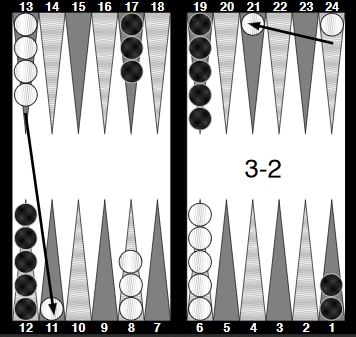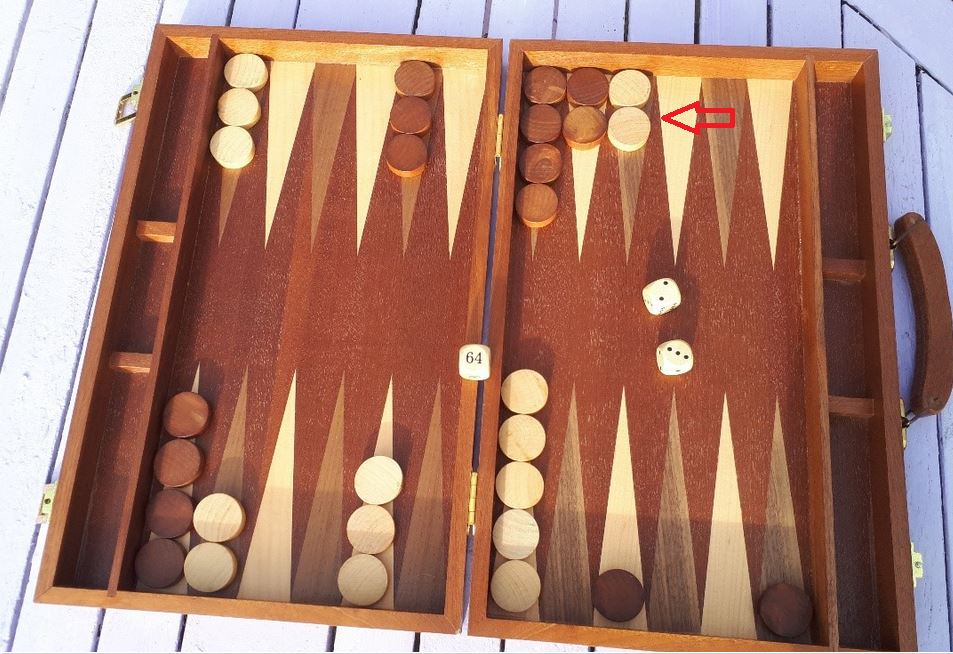Last updated on May 27, 2024
This Deluxe Backgammon post is another in our series for absolute beginners. In this instance, we look at the importance of advanced anchors in backgammon. An anchor is a secure point within your opponent’s home board. At the start of the game, your back checkers form an anchor on your opponent’s 1-point. Although secure, it is too deep in the board to be of strategic use, an advanced anchor is formed higher in the board, usually on the 5 or 4-points.
A typical beginner’s mistake is to lose focus on the back checkers, they consider them to be safe on a secure point. As a result, they get trapped behind a prime. The best way to prevent getting trapped behind a prime is to secure an advanced anchor early in the game. An advanced anchor is a secure point on the opponent’s 5-point, 4-point, 3-point or sometimes the bar-point. Note that some players consider the 3-point and bar-point to be marginal when considering advanced anchors. The advanced anchor is one of the most important positional features in backgammon. It limits your opponent’s offensive plans as they are unable to build an effective home-board prime and they are vulnerable to hits on their outer board.
Strategic advantages
In general, most backgammon players know an advanced anchor is important, but usually, they underestimate just how strategically important it is. Advanced anchors have these strategic advantages.
- Your back checkers are closer to home.
- It is much harder for your opponent to build a prime to block the back checkers.
- As long as you keep your anchor in your opponent’s home board you always have a secure landing point for your checkers, that you need to re-enter from the bar after being hit.
- You control the outfield, which your opponents have to move checkers as they advance toward their home board. This will provide opportunities to hit from your anchor.
- The advanced position in your opponent’s home board should provide an easier escape if you decide to break and run.
Securing an advanced anchor should be one of the primary goals in the opening stages of the game.
Once you have the advanced anchor, you can concentrate on developing other parts of the board Additionally, you can play more freely knowing you have a secure landing point. Some of the opening moves provide excellent opportunities for developing an advanced anchor on subsequent rolls.
5-4
The 5-4 opening roll is best played as 24/20, 13/8. It’s a balanced play, creating opportunities on both sides of the board. However, the risk here is that the blot on your opponent’s 5-point will be a target. Though, if you are not hit and you roll a 4 on your next turn you will secure the 5-point in your opponent’s home board and create an advanced anchor. This is a premium position that will cause problems for your opponent. The 13/8 can be used as a spare builder or to hit advancing checkers on subsequent moves.

3-2
The 3-2 opening roll provides another chance to work towards building an advanced anchor, by moving 24/21, 13/11. Like the 5-4 opening move, the 3-2, is a balanced play, creating opportunities on both sides of the board. The 24/21 moves one of the back checkers forward. If it doesn’t get hit, it provides an opportunity to create an advanced anchor on a subsequent move. The 13/11 brings a builder down to a relatively safe position where it can be used in the next move to secure a point.

Breaking the anchor
Once you have an advanced anchor, the most difficult decision is to know when to break it. There are two reasons to break the anchor, the first is to run. This might happen if you roll a large double and have the opportunity to break contact with a significant lead in the race. The other reason would be the opportunity to hit a blot in the opponent’s outer board. This is a particularly good choice if you have a strong home board. Once you break the advanced anchor you are committed to a change in your strategic play as your checkers can only move forward, not back. The only way to get the advanced anchor back is if one of your checkers is hit and you can re-build upon re-entry.
Ultimately, the anchor needs to be broken. You cannot win the game if your back checkers remain in your opponent’s home board. The dilemma is knowing exactly when to break the advanced anchor. If you break it too early and get hit, you have lost your safe point of entry and risk being closed out. If you hold on too long, your back checkers could be blocked by a 6-prime and you will be forced to crunch your checkers in your own home board.
The decision to abandon the anchor should be based on your position in the race. Compare the pip counts and break when it is to your advantage. If you are significantly behind in the race, refrain from breaking the anchor and play a holding game. If you hold the advantage, break and run. It can be a difficult decision, which needs to be timed correctly and there will be times when the dice rolls will force you to make the break.
Related content
Advanced Anchor description at Backgammon Galore.


I’m new to backgammon and play socially in my local pub, the loser of the first to 3 match buys the pint. Normally I try and get my back checkers out as quickly as possible, but this article is making me think again. Having a safe landing place makes sense in certain situations.
Hi Roy, obviously you have to escape your back checkers if you are to win at backgammon. If you roll big numbers running is an effective backgammon strategy, but it won’t work in every scenario. There will be times when you are hit and forced to play back game or holding strategies, this is when the advanced anchors are crucial. If you want to improve your backgammon, learn all of the strategies and be flexible. It may be that you change your strategy multiple times during a single game. Read a few of our backgammon playing guides, apply what you learn and beat your mates in your local, they’ll be buying the pints! Thanks for taking the time to comment, Jason